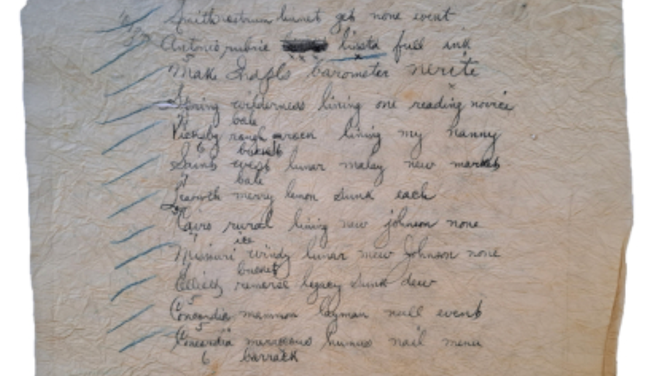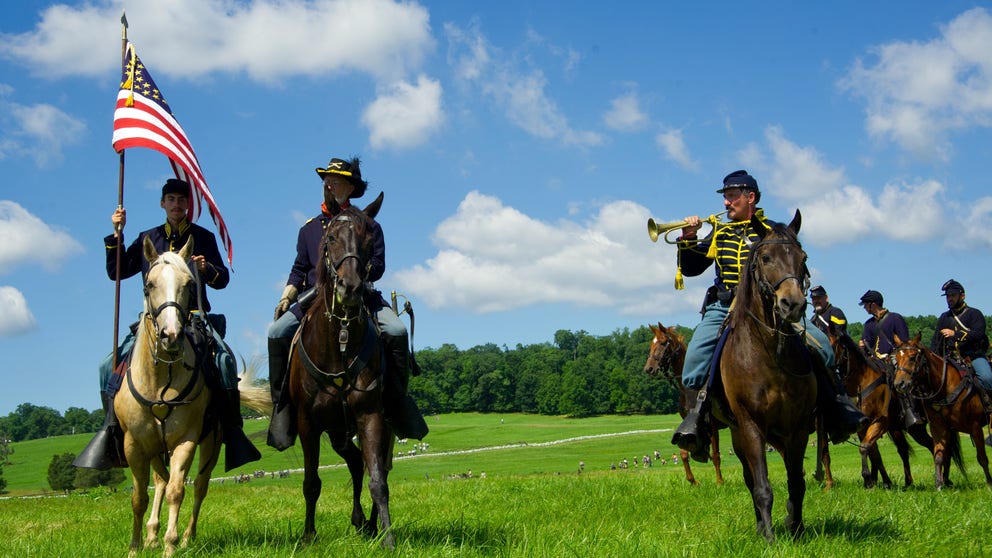Cryptic notes hidden in 19th-century silk dress reveal weather story
The messages were cryptic, containing lines of text filled with seemingly random words and numbers.
FILE: Recreating History
Battle reenactments bring military and weather history to life.
Within a secret pocket of a brown silk dress, paper notes containing messages written in code were discovered after being hidden for more than 100 years.
The dress was a silk bustle dress from the 1880s, according to NOAA, and it was found by Sara Rivers Cofield in an antique mall in Maine in 2013. Upon closer inspection, Rivers Cofield discovered the handwritten notes inside a secret pocket sewn into the seams of the skirt bustle.
The notes were cryptic, containing lines of text filled with seemingly random words. For example, one line read "Bismark, omit, leafage, buck, bank."

Three views of the 1880s silk bustle dress in which crumpled bits of paper containing a code were found. The pocket where the code was found is located under the overskirt at the right hip.
(Sara Rivers Cofield / NOAA)
Rivers Cofield posted about her discovery online, hoping to crowdsource some help deciphering the messages.
During that time, her online community suggested that the messages could possibly be written for a telegram. Given the brevity and staccato nature of the notes, along with the dress coming from a time when sending telegrams became a common form of community, this lead seemed promising.
THE HISTORY OF GEORGE WASHINGTON'S WEATHERVANE
However, the meaning of the messages remained a mystery for 10 more years.
"The silk dress cryptogram, as it came to be known, was considered by expert and amateur cryptogram lovers the world over to be one of the top 50 unsolvable codes in the world," NOAA said.

One of the messages found in the silk dress.
(Sara Rivers Cofield / NOAA)
A breakthrough occurred when University of Manitoba researcher Wayne Chan, who solves codes as a hobby, realized that the code words in the notes were similar to those used by the U.S. Army Signal Corps to discuss the weather.
This era is one that Chan referred to as "a bygone time when the telegraph ushered in a new era for operational meteorology."
HOW THE TELEGRAPH HELPED CREATE ONE OF AMERICA'S FIRST WEATHER OBSERVATION NETWORKS
To confirm this connection between the telegraph and silk dress cryptogram, Chan was able to pore through a PDF copy of a weather telegraph code book from 1892 and is currently available at NOAA’s Central Library in Silver Spring, Maryland.
Titled "Weather Code," the book was published by the Weather Bureau within the U.S. Department of Agriculture.

The title page of the Weather Bureau’s 1892 Weather Code book.
(Sean Jones, NOAA Central Library / NOAA)
Chan also sifted through other NOAA resources, which helped him confirm that the messages were from Signal Service weather stations, or stations that sent and translated coded telegrams about the weather, in the U.S. and Canada.
He learned that each line in the messages contained codes about weather observations at certain locations. For example, the line "Bismark, omit, leafage, buck, bank" meant the following, according to NOAA:
- BISMARK Station name: Bismarck, Dakota Territory (in present-day North Dakota)
- OMIT Air temperature: 56 F Barometric pressure: 0.08 in Hg (According to NOAA, only the fractional part of the pressure value was telegraphed, unless the station was west of the 97th meridian or the pressure was below 29.4 in Hg or above 30.38 in Hg). In this case, the actual reading was 30.08 in Hg)
- LEAFAGE Dew point: 32°F Observation time: 10:00 p.m.
- BUCK State of weather: Clear Precipitation: None Wind direction: North
- BANK Current wind velocity: 12 mph Sunset: Clear

FILE: Telegrapher Bob Branchaud taps out a period in Morse Code on a hand key in his home office in Cottage Grove, Minnesota. April 20, 2004.
(JOEY MCLEISTER / Star Tribune / Getty Images)
Chan also discovered that the weather observations were taken on May 27, 1888.
As far as the woman who wrote the coded messages and wore the brown silk dress, nobody knows. Chan followed a possible lead to a Signal Service office in Washington, D.C., but it led to a dead end, leaving the woman behind the messages a mystery…for now.
